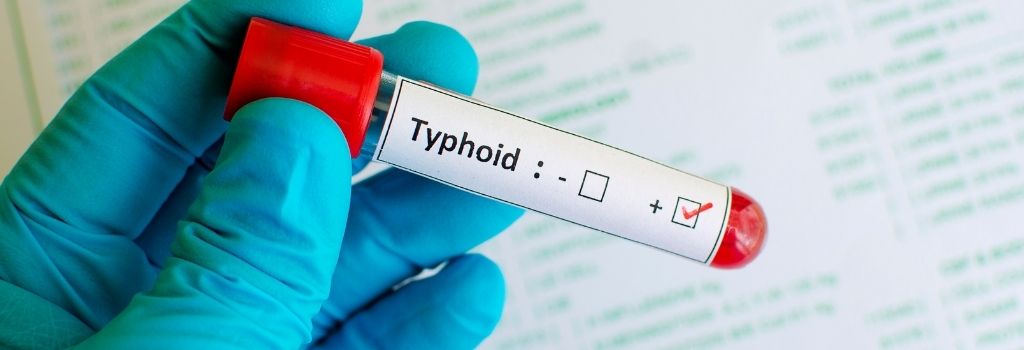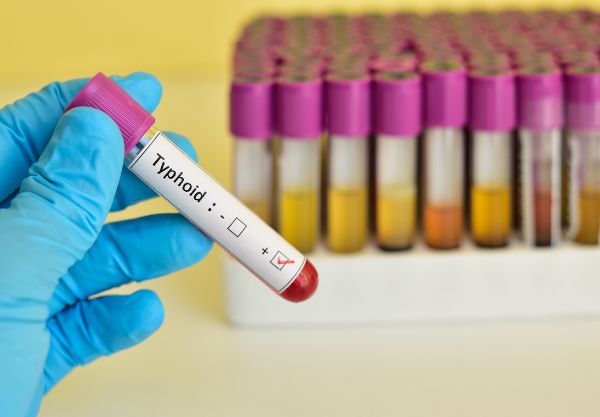Table of Contents
Typhoid fever is a significant health concern in developing countries, particularly in regions with limited access to clean water, sanitation and healthcare resources. Caused by Salmonella enterica serotype Typhi, typhoid fever is primarily transmitted through contaminated food and water. Rapid diagnosis and timely treatment are essential to controlling outbreaks and preventing complications. One of the most effective tools for early detection of typhoid is the Typhoid Rapid Test Kit. This guide explains how to identify and manage typhoid risks using rapid test kits in high-risk countries, with a focus on regions in Indo-China such as Laos, Cambodia, Vietnam, Thailand and Myanmar.

Understanding Typhoid Fever and Its Symptoms
Typhoid fever presents a range of symptoms that can vary in severity. Early diagnosis is critical to managing the disease before it leads to severe complications. Common symptoms of typhoid fever include:
- High fever: A fever of 39°C (102.2°F) or higher, often with a gradual onset.
- Fatigue and weakness: These symptoms are common and can be debilitating.
- Abdominal pain: Most often experienced in the lower abdomen.
- Headache: A frequent symptom in the early stages.
- Loss of appetite and nausea: Patients often experience a significant loss of appetite.
- Digestive disturbances: Either diarrhea or constipation is common.
In high-risk areas, where typhoid fever is endemic, recognizing these symptoms early is essential for reducing the spread of the disease and ensuring appropriate treatment.

Causes and Risk Factors for Typhoid Outbreaks
Typhoid fever is primarily spread through the consumption of contaminated food or water, with risk factors varying depending on the location. In countries with limited sanitation infrastructure, the risk of transmission is significantly higher. Some key causes and risk factors for typhoid outbreaks include:
- Poor sanitation: In countries like Laos, Cambodia and Myanmar, where clean water access is limited, typhoid outbreaks are common due to contaminated water sources and improper disposal of waste.
- Overcrowded urban environments: High population densities, particularly in cities like Vientiane, Phnom Penh and Hanoi, can contribute to the spread of typhoid, especially when sanitation is inadequate.
- Travel and migration: Movement of people between high-risk and low-risk areas increases the chance of outbreaks. Tourists or migrants who have not been vaccinated against typhoid may unknowingly bring the disease into regions where it is not as prevalent.
- Inadequate healthcare access: In rural and underdeveloped areas, healthcare infrastructure is often insufficient, making it harder to diagnose and treat typhoid early.
In regions like Laos, Cambodia, Vietnam, Thailand and Myanmar, these factors significantly contribute to the persistence and spread of typhoid fever.
Typhoid Test Kits: A Key Diagnostic Tool
Rapid diagnostic testing is essential in high-risk areas for quick and accurate identification of typhoid cases. One of the most effective diagnostic tools for early detection is the typhoid rapid test kit. These test kits detect the presence of Salmonella Typhi antigens and antibodies in the blood, providing results within 15 to 20 minutes.
Types of Typhoid Test Kits

There are several types of diagnostic tests used to detect typhoid fever, each with varying degrees of accuracy and ease of use. Among them are:
- Blood cultures: The gold standard for typhoid diagnosis but requires laboratory resources and several days to produce results.
- Widal test: A traditional serological test that detects antibodies against Salmonella Typhi. However, it is less reliable than newer tests.
- Typhoid IgG+IgM Rapid Test Kits: These kits are ideal for point-of-care testing in resource-limited settings. They are simple to use, give quick results and are cost-effective.
The typhoid rapid test kit is particularly effective for diagnosing early-stage infections, where symptoms may be nonspecific or difficult to distinguish from other illnesses.
Risk of Typhoid Rapid Kits in Laos
Laos faces a high risk of typhoid fever, particularly in rural areas where sanitation and healthcare access are limited. The capital, Vientiane and other urban centers are prone to outbreaks due to inadequate water treatment and contamination during the rainy season.
In such areas, typhoid rapid kits can be life-saving, enabling healthcare providers to quickly screen individuals who exhibit symptoms like fever and abdominal pain. Early detection through rapid testing can facilitate immediate treatment and prevent the disease from spreading further. With the availability of reliabletest kits, healthcare workers can diagnose and manage typhoid even in remote regions, ensuring timely care for affected individuals.
Typhoid Test Kits in Cambodia
Cambodia is another country at significant risk for typhoid fever, especially in regions where access to clean water and sanitation services is limited. The capital city, Phnom Penh and rural areas are particularly vulnerable to typhoid outbreaks, which often occur following the monsoon season when flooding contaminates drinking water.
To mitigate these risks, the use of typhoid test kits can significantly reduce diagnostic delays. Healthcare professionals can quickly identify infected individuals and begin treatment, reducing the risk of further transmission. These kits are especially valuable in resource-poor settings, where laboratory testing may not be available, ensuring that typhoid cases are managed promptly and effectively.
Risk of Typhoid Rapid Kits in Vietnam
Vietnam is another high-risk country for typhoid fever, with high population density and varying levels of access to sanitation. In Hanoi, the capital, typhoid outbreaks are often associated with contaminated water sources during the rainy season. With the country’s ongoing urbanization, areas such as Ho Chi Minh City also experience a heightened risk of typhoid transmission.
The Typhoid Rapid Kit is an invaluable tool in managing these risks. It can be used in both urban and rural areas, offering healthcare providers a quick and effective way to detect typhoid in individuals who may not have access to advanced diagnostic facilities. By using rapid test kits, healthcare workers can ensure that patients receive appropriate treatment in a timely manner.
Typhoid Test Kits – Risk in Thailand
Although Thailand has made significant progress in improving healthcare infrastructure, typhoid remains a risk, especially in rural regions. Overcrowding and the influx of tourists increase the chances of outbreaks in areas like Bangkok. In addition, flooding during the rainy season exacerbates the risk of waterborne diseases, including typhoid.
In these areas, the use of Typhoid Test Kits, is crucial for early diagnosis. These kits can provide fast and accurate results, helping healthcare providers treat patients early and reduce the spread of the disease.
Typhoid Rapid Test Kits Risk in Myanmar
Myanmar, with its rural communities and limited healthcare access, remains highly susceptible to typhoid fever. The capital city, Naypyidaw and major cities like Yangon experience periodic outbreaks, particularly in areas with poor sanitation. Additionally, the lack of adequate healthcare infrastructure in rural areas complicates efforts to control the disease.
The Typhoid Rapid Test Kit is an essential tool in managing typhoid risk in Myanmar. By using these kits, healthcare professionals can diagnose the disease in its early stages and begin treatment before complications arise. The rapid nature of these tests is especially valuable in rural clinics where laboratory facilities may be scarce.
Managing Typhoid Risk with Rapid Test Kits
Effective management of typhoid fever in high-risk countries hinges on rapid diagnosis and timely intervention. The test kit is a crucial tool for healthcare providers in countries like Laos, Cambodia, Vietnam, Thailand and Myanmar. These test kits allow for:
- Quick diagnosis: With results available in as little as 15-20 minutes, healthcare providers can swiftly identify typhoid cases.
- Affordable and accessible testing: The cost-effectiveness of rapid test kits makes them an ideal solution for areas with limited resources.
- Prevention of outbreaks: Early detection of typhoid leads to faster treatment, reducing the risk of community-wide outbreaks.
- Improved healthcare response: Rapid testing enhances the ability of health systems to respond to typhoid outbreaks quickly, even in remote or underserved regions.
By using Typhoid Test Kits with effective management strategies, countries in Indo-China can better control typhoid fever, preventing both individual and community-level morbidity and mortality.

Conclusion
Jal Medical, as a leading Typhoid Rapid Test Kits distributors and suppliers is crucial for managing typhoid risk in high-risk countries such as Laos, Cambodia, Vietnam, Thailand and Myanmar. By enabling fast and accurate diagnosis, these kits help healthcare providers respond promptly to outbreaks, ensuring that individuals receive the necessary treatment without delay. With widespread use of rapid test kits, countries in the Indo-China region can significantly reduce the impact of typhoid fever on public health.
FAQs
What is the Typhoid IgG+IgM Rapid Test Kit?
The Typhoid IgG+IgM Rapid Test Kit is a diagnostic tool that detects antibodies against Salmonella Typhi in the blood. It provides quick, accurate results, typically within 15-20 minutes.
How does the Typhoid Rapid Test work?
The test identifies IgG and IgM antibodies produced by the body in response to Salmonella Typhi infection. A positive result indicates that the person has been exposed to the bacteria.
Can the Typhoid Rapid Test be used in rural areas?
Yes, the Typhoid Rapid Test Kit is designed for use in rural and underserved areas with limited access to advanced diagnostic tools. It requires minimal training and provides fast results.
What are the benefits of using the Typhoid Rapid Test Kit?
The main advantages include fast results, ease of use, cost-effectiveness and the ability to diagnose typhoid quickly, even in resource-limited settings.

